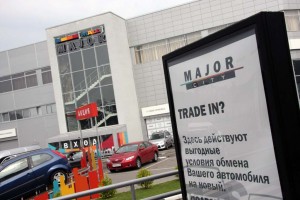
The Russian automotive market continues to suffer, but officials hope soon-to-be-enacted measures will help.
Already deep into the doldrums, the Russian automotive market has yet to bottom out, though Russian negotiators are hoping to take a critical step towards turning around the country’s moribund economy in the coming weeks.
Automotive sales started the New Year out pretty much the same way 2015 ended, with another severe drop in demand. The prospects for Russia’s car market have been so bleak that General Motors last year announced it would shut down its operations there.
The heart of the former Soviet Union has been hard hit by a variety of negative economic factors, including sanctions heaped onto Russia following its annexation of the Crimean Peninsula and its support of Ukranian separatists. But the biggest problem has been the severe slump in the price of oil.
Oil has accounted for as much as 60% of Russia’s exports and a third of its GDP in recent years, so with oil prices hovering in the $30 a barrel range, the country has seen its economic fortunes collapse, unemployment surging, and spending power rapidly declining.
(Ford expected continued growth, profits in Europe. For more, Click Here.)
Car sales fell 36% last year, to just 1.6 million, the lowest level since 2009, according to the Moscow—based Association of European Businesses. Demand fell another 29% in January 2016, marking the 34th monthly year-over-year decline out of the last 37 months, reports the AEB.
That’s far worse than most observers had been anticipating, with 2016 sales, overall, forecast to drop a more modest 10%. But with the ruble taking another tumble in recent weeks, it’s far from certain that January marked the low point for the Russian automotive market, according to industry analysts.
Lada, the local Russian brand, suffered a relatively modest 10% dip in January, while Nissan was down a full 50%, with Volkswagen, Toyota, Hyundai and Renault not far behind.
(Click Here for details about how global auto sales rose in 2015.)
General Motors, which ended Russian production and has pulled out all but a handful of niche models, saw demand for its Opel products tumble 74% last year. It will largely fade out of the market by the end of 2016.
Lada’s Granta was one of the few models to see relatively stable sales. The best-selling model in the Russian market was down just 4.7% for January, while second best-selling Hyundai Solaris was off 31.5%.
While the economic indicators aren’t very solid, Russia could be seeing the first sign of light at the end of its very dark economic tunnel. Negotiators are working up an agreement with OPEC’s de facto leader, Saudi Arabia, to finally put a cap on oil production.
(Newly open Iran not a windfall for U.S. auto makers. Click Here for the story.)
Declining demand and a huge global glut of petroleum has led to a massive plunge in the price of oil. But a move to rein in production could set prices heading back upwards, according to analysts. But that’s far from certain. With its own Western sanctions lifted, Iran is looking to rapidly ramp up its own petro production and that could offset the benefits of any Russo-Saudi deal. In turn, without a revival of oil prices it’s anyone’s guess when the Russian economy – or its car market – will recover.
